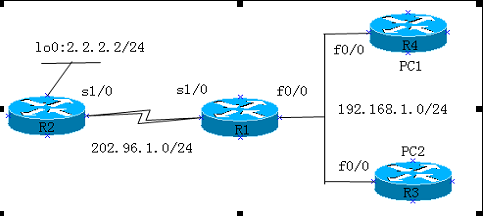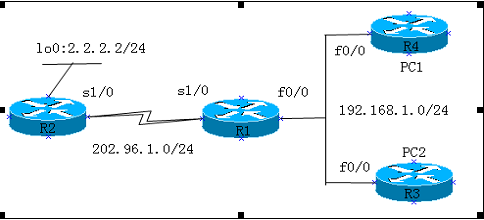实验17:NAT
实验14-1:静态NAT 配置
Ø 实验目的
通过本实验可以掌握
(1)静态NAT 的特征
(2)静态NAT 基本配置和调试
Ø 拓扑结构

实验步骤
n 步骤1:配置路由器R1 提供NAT 服务
R1(config)#ip nat inside source static 192.168.1.1 202.96.1.3
R1(config)#ip nat inside source static 192.168.1.2 202.96.1.4
//配置静态NAT 映射
R1(config)#interface f0/0
R1(config)#ip add 192.168.1.254 255.255.255.0
R1(config-if)#no sh
R1(config-if)#ip nat inside
//配置NAT 内部接口
R1(config)#interface s1/0
R1(config-if)#ip add 202.96.1.1 255.255.255.0
R1(config-if)#no sh
R1(config-if)#ip nat outside
//配置NAT 外部接口
R1(config)#router rip
R1(config-router)#version 2
R1(config-router)#no auto-summary
R1(config-router)#network 202.96.1.0
n 步骤2:配置路由器R2
Router(config)#host R2
R2(config)#int s1/0
R2(config-if)#ip add 202.96.1.2 255.255.255.0
R2(config-if)#int lo0
R2(config-if)#ip add 2.2.2.2 255.255.255.0
R2(config)#router rip
R2(config-router)#version 2
R2(config-router)#no auto-summary
R2(config-router)#network 202.96.1.0
R2(config-router)#network 2.0.0.0
Ø 实验调试
n debug ip nat
该命令可以查看地址翻译的过程。
在PC1 和PC2 上Ping 2.2.2.2(路由器R2 的环回接口),此时应该是通的,路由器R1的输出信息如下:
PC1#ping 2.2.2.2
Type escape sequence to abort.
Sending 5, 100-byte ICMP Echos to 2.2.2.2, timeout is 2 seconds:
!!!!!
Success rate is 100 percent (5/5), round-trip min/avg/max = 12/52/104 ms
PC2#ping 2.2.2.2
Type escape sequence to abort.
Sending 5, 100-byte ICMP Echos to 2.2.2.2, timeout is 2 seconds:
!!!!!
Success rate is 100 percent (5/5), round-trip min/avg/max = 36/69/112 ms
R1#debug ip nat
*Mar 1 00:14:24.799: NAT*: s=192.168.1.1->202.96.1.3, d=2.2.2.2 [0]
*Mar 1 00:14:24.835: NAT*: s=2.2.2.2, d=202.96.1.3->192.168.1.1 [0]
*Mar 1 00:14:24.887: NAT*: s=192.168.1.1->202.96.1.3, d=2.2.2.2 [1]
*Mar 1 00:14:24.947: NAT*: s=2.2.2.2, d=202.96.1.3->192.168.1.1 [1]
………………….
*Mar 1 00:15:19.239: NAT*: s=192.168.1.2->202.96.1.4, d=2.2.2.2 [0]
*Mar 1 00:15:19.267: NAT*: s=2.2.2.2, d=202.96.1.4->192.168.1.2 [0]
*Mar 1 00:15:19.299: NAT*: s=192.168.1.2->202.96.1.4, d=2.2.2.2 [1]
*Mar 1 00:15:19.311: NAT*: s=2.2.2.2, d=202.96.1.4->192.168.1.2 [1]
以上输出表明了NAT 的转换过程。首先把私有地址“192.168.1.1”和“192.168.1.2”
分别转换成公网地址“202.96.1.3”和“202.96.1.4”访问地址“2.2.2.2”,然后回来的时候把公网地址“202.96.1.3”和 “202.96.1.4”分别转换成私有地址“192.168.1.1”和“192.168.1.2”。
n show ip nat translations
该命令用来查看NAT 表,静态映射时,NAT 表一直存在
R1#show ip nat translations
Pro Inside global Inside local Outside local Outside global
--- 202.96.1.3 192.168.1.1 --- ---
--- 202.96.1.4 192.168.1.2 --- ---
以上输出表明了内部全局地址和内部局部地址的对应关系。
【术语】
① 内部局部(inside local)地址:在内部网络使用的地址,往往是RFC1918 地址;
② 内部全局(inside global)地址:用来代替一个或多个本地IP 地址的、对外的、
向NIC 注册过的地址;
③ 外部局部(outside local)地址:一个外部主机相对于内部网络所用的IP 地址。
不一定是合法的地址;
④ 外部全局(outside global)地址:外部网络主机的合法IP 地址。
实验14-2:动态NAT
Ø 实验目的
通过本实验可以掌握:
(1)动态NAT 的特征
(2)动态NAT 配置和调试
Ø 拓扑结构

实验步骤
n 步骤1 : 实验前先删除实验13-1的静态NAT的配置
R1(config)#no ip nat inside source static 192.168.1.1 202.96.1.3
R1(config)#no ip nat inside source static 192.168.1.2 202.96.1.4
n 步骤2:配置路由器R1 提供NAT 服务
R1(config)#ip nat pool NAT 202.96.1.3 202.96.1.100 netmask 255.255.255.0 //配置动态NAT 转换的地址池
R1(config)#ip nat inside source list 1 pool NAT
//配置动态NAT 映射
R1(config)#access-list 1 permit 192.168.1.0 0.0.0.255
//允许动态NAT 转换的内部地址范围
R1(config)#interface f0/0
R1(config-if)#ip nat inside
R1(config-if)#interface s1/0
R1(config-if)#ip nat outside
Ø 实验调试
在PC1 上ping 2.2.2.2(路由器R2 的环回接口),在PC2 上分别telnet 2.2.2.2(路由器R2 的环回接口),调试结果如下:
n debug ip nat
R1#debug ip nat
*Mar 1 00:31:18.327: NAT*: s=192.168.1.1->202.96.1.4, d=2.2.2.2 [10]
*Mar 1 00:31:18.383: NAT*: s=2.2.2.2, d=202.96.1.4->192.168.1.1 [10]
……………………….
*Mar 1 00:31:28.215: NAT*: s=192.168.1.2->202.96.1.3, d=2.2.2.2 [49342]
*Mar 1 00:31:28.307: NAT*: s=2.2.2.2, d=202.96.1.3->192.168.1.2 [17311]
【提示】
如果动态NAT 地址池中没有足够的地址作动态映射,则会出现类似下面的信息,提示NAT 转换失败,并丢弃数据包。
*Feb 22 09:02:59.075: NAT: translation failed (A), dropping packet s=192.168.1.2 d=2.2.2.2
n show ip nat translations
R1#show ip nat tran
Pro Inside global Inside local Outside local Outside global
icmp 202.96.1.5:3 192.168.1.1:3 2.2.2.2:3 2.2.2.2:3
--- 202.96.1.5 192.168.1.1 --- ---
tcp 202.96.1.3:62479 192.168.1.2:62479 2.2.2.2:23 2.2.2.2:23
--- 202.96.1.3 192.168.1.2 --- ---
以上信息表明当PC1 和PC2 第一次访问“2.2.2.2”地址的时候,NAT 路由器R1 为主机PC1 和PC2 动态分配两个全局地址“202.96.1.5”和“202.96.1.3,在NAT 表表中生成两条动态映射的记录,同时会在NAT 表中生成和应用向对应的协议和端口号的记录(过期时间为60 秒)。在动态映射没有过期(过期时间为86400 秒)之前,再有应用从相同主机发起时,NAT 路由器直接查NAT表,然后为应用分配相应的端口号。
n show ip nat statistics
该命令用来查看NAT 转换的统计信
R1#show ip nat statistics
Total active translations: 2 (0 static, 2 dynamic; 0 extended)
//有2个转换是动态转化,
Outside interfaces:
Serial1/0 //NAT 外部接口
Inside interfaces:
FastEthernet0/0
Hits: 107 Misses: 10 //NAT 内部接口
CEF Translated packets: 117, CEF Punted packets: 0
Expired translations: 8 //NAT 表中过期的转换
Dynamic mappings: //动态映射
-- Inside Source
[Id: 1] access-list 1 pool nat refcount 2
pool nat: netmask 255.255.255.0 //地址池名字和掩码
start 202.96.1.3 end 202.96.1.100 //地址池范围
type generic, total addresses 98, allocated 2 (2%), misses 0
//共98 个地址,分出去2 个
Queued Packets: 0
实验14-3: PAT 配置
实验目的
通过本实验可以掌握:
(1)PAT 的特征
(2)overload 的使用
(3)PAT 配置和调试
Ø 拓扑结构

实验步骤
n 步骤1 : 实验前先删除实验13-2的动态NAT的配置
R1(config)#no ip nat inside source list 1 pool NAT
n 步骤2 : 配置路由器R1 提供NAT 服务
R1(config)#ip nat pool NAT 202.96.1.3 202.96.1.100 netmask 255.255.255.0
R1(config)#ip nat inside source list 1 pool NAT overload //配置PAT
R1(config)#access-list 1 permit 192.168.1.0 0.0.0.255
R1(config)#interface f0/0
R1(config-if)#ip nat inside
R1(config-if)#interface s1/0
R1(config-if)#ip nat outside
Ø 实验调试
在PC1 上ping 2.2.2.2(路由器R2 的环回接口),在PC2 上分别telnet 2.2.2.2(路由器R2 的环回接口),调试结果如下:
n debug ip nat
R1#debug ip nat
*Mar 1 00:54:32.479: NAT*: s=192.168.1.1->202.96.1.3, d=2.2.2.2 [20]
*Mar 1 00:54:32.551: NAT*: s=2.2.2.2, d=202.96.1.3->192.168.1.1 [20]
……………………
*Mar 1 00:54:42.451: NAT*: s=192.168.1.2->202.96.1.3, d=2.2.2.2 [19447]
*Mar 1 00:54:42.579: NAT*: s=2.2.2.2, d=202.96.1.3->192.168.1.2 [12582]
n show ip nat translations
R1#show ip nat tran
Pro Inside global Inside local Outside local Outside global
icmp 202.96.1.3:5 192.168.1.1:5 2.2.2.2:5 2.2.2.2:5
tcp 202.96.1.3:27119 192.168.1.2:27119 2.2.2.2:23 2.2.2.2:23
以上输出表明进行PAT 转换使用的是同一个IP 地址的不同端口号。
n show ip nat statistics
R1#show ip nat statistics
Total active translations: 0 (0 static, 0 dynamic; 0 extended)
Outside interfaces:
Serial1/0
Inside interfaces:
FastEthernet0/0
Hits: 155 Misses: 14
CEF Translated packets: 169, CEF Punted packets: 0
Expired translations: 12
Dynamic mappings:
-- Inside Source
[Id: 2] access-list 1 pool nat refcount 0
pool nat: netmask 255.255.255.0
start 202.96.1.3 end 202.96.1.100
type generic, total addresses 98, allocated 0 (0%), misses 0
Queued Packets: 0
【提示】
动态NAT 的过期时间是86400 秒,PAT 的过期时间是60 秒,通过命令“show ip nat translations verbose”可以查看。也可以通过下面的命令来修改超时时间:
R1(config)#ip nat translation timeout timeout
//参数timeout 的范围是0-2147483。
如果主机的数量不是很多, 可以直接使用outside 接口地址配置PAT,不必定义地址池,命令如下:
R1(config)#ip nat inside source list 1 interface s1/0 overload
最新文章
- Linux环境数据备份Python脚本
- js 数组赋值问题 :值传递还是引用?
- Careercup - Google面试题 - 4557716425015296
- bzoj 3242: [Noi2013]快餐店 章鱼图
- hdu 1788 Chinese remainder theorem again(最小公倍数)
- Ajax实现三级联动(0520)
- docker 现实---中小企业docker环境结构(五)
- PAT (Advanced Level) 1101. Quick Sort (25)
- 3D GIS 应用开发 —— 基于 Mapbox GL 的实践总结
- Python发邮件的小脚本
- 使用脚本与orm模型交互对数据库操作
- 数学集合:N Z Q R C
- TCP客户端【TcpClient】
- maven 项目 编码
- Java 8 新日期时间 API
- 通过http请求传递xml流和接收xml流的代码示例
- ZetCode PyQt4 tutorial work with menus, toolbars, a statusbar, and a main application window
- [转]Porting to Oracle with Entity Framework NLog
- UIImageView只显示一半
- 时区缩写 UTC, CST, GMT, CEST 以及转换